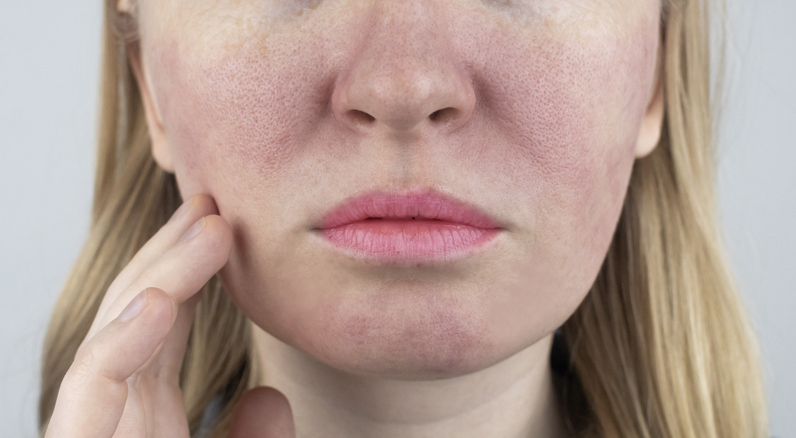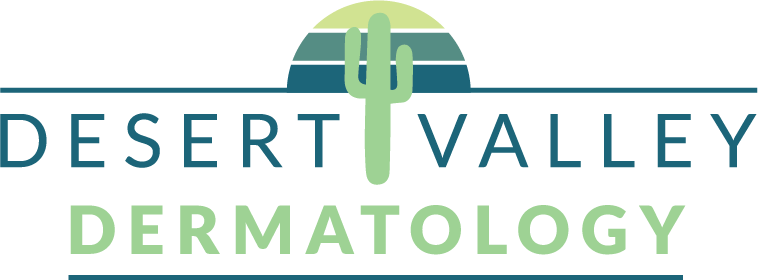Rosacea Treatment in Phoenix
Desert Valley Dermatology offers a comprehensive range of rosacea treatments to address the unique needs of patients.
Rosacea is a persistent skin disease that affects millions of people worldwide. While rosacea is not a physically debilitating or life-threatening medical condition, it can nonetheless significantly impact quality of life.
The physical symptoms of rosacea, such as redness and flushing, can be a source of self-consciousness and embarrassment. These physical changes can profoundly impact patients’ self-perception and how they navigate their daily lives.

Fortunately, rosacea is manageable. By implementing the appropriate skincare routine and seeking medical rosacea treatment, patients can significantly improve their quality of life and overcome the challenges of living with rosacea.
At Desert Valley Dermatology, the well-being of our patients is our top priority. We understand that living with rosacea can be challenging, and our dermatologists strive to provide supportive and individualized care every step of the way.
What is Rosacea?
Rosacea is characterized by swelling, redness, and visible blood vessels on the face. It primarily affects the central face, including the cheeks, nose, forehead, and chin. Rosacea is not communicable or caused by hygiene issues.
What Causes Rosacea?
The exact causes of rosacea are not yet known. However, several issues are believed to contribute to its development. These issues include the following:
- Abnormal immune response
- Response to common skin bacteria
- Blood vessel disorders that increase blood flow to the face
- Certain medications, like vasodilators
Most people afflicted with the condition who are not receiving rosacea treatment have sensitivities to certain foods and conditions.
- Spicy foods
- Alcoholic beverages
- Caffeinated beverages
- Sun exposure
- Extreme weather conditions
- Stress or anxiety
- Exercise
Anyone can get rosacea. However, the following groups of people are at a higher risk for the condition:
- Adults over the age of 30
- Women and people assigned female at birth
- People with a family history of rosacea
- People with light skin
What are Rosacea Symptoms?
The symptoms of rosacea can vary from person to person and can range from mild to severe. Common rosacea symptoms include persistent facial redness, flushing, and small red bumps or pus-filled pimples. These symptoms can progress over time to include enlarged blood vessels, persistent redness, and thickened skin. In more severe cases, there may be swelling, burning, and eye involvement.
Types of Rosacea
There are four recognized types of rosacea.
Erythematotelangiectatic Rosacea (ETR)
ETR is a type of rosacea that affects the skin’s blood vessels. The following conditions are associated with ETR:
- Redness and flushing: One of the most prominent features of ETR is persistent redness on the cheeks, nose, forehead, and chin. This redness can be intense and persistent, often resembling sunburn. The flushing might intensify in response to triggers such as spicy foods, alcohol, stress, and hot weather.
- Visible blood vessels: Visible blood vessels, known as telangiectasias, are often visible in the affected areas of the skin. These blood vessels appear as red lines or web-like patterns on the skin’s surface.
- Inflammation: Some people experience visible inflammation and swelling, sometimes accompanied by burning or stinging.
Papulopustular Rosacea
Papulopustular rosacea, commonly called acne rosacea, presents with symptoms similar to ETR. However, people with this category of rosacea also have pimples and pustules that resemble acne vulgaris.
In addition to the redness, visible blood vessels, and inflammation common to ETR, papulopustular rosacea symptoms include the following:
- Papules: Rosacea papules are small, flesh-colored, or red bumps that can occur individually or in groups. These bumps are often confused with acne, but they are typically more persistent and widespread on the face.
- Pustules: Rosacea pustules are small, pus-filled bumps.
Phymatous Rosacea
Phymatous rosacea is a severe form of rosacea; it is characterized by the same redness, flushing, and inflammation associated with ETR and papulopustular rosacea. However, phymatous rosacea is also noted for the following symptoms:
- Swelling: The skin becomes swollen and bumpy, resembling an elephant’s hide.
- Pimple-like bumps: Small, red bumps that resemble acne may develop.
- Rough texture: The skin may feel scaly and thick.
- Enlarged pores: Severe phymatous rosacea can cause additional tissue growth, leading to irregularities in the skin that can lead to blocked and enlarged pores.
Ocular Rosacea
Ocular rosacea affects the eyes and surrounding tissue. It is not an isolated disorder; it is a manifestation of rosacea. While most people who experience ocular rosacea will have skin symptoms like redness and flushing, it is possible to have ocular rosacea without having noticeable skin changes.
Ocular rosacea symptoms include the following:
- Burning or itchy eyes
- Red eyes
- Vision abnormalities
- Visible blood vessels in the eyes
- Inflamed eyelids
- Persistent eye infections like sties or pink eye
What Rosacea Treatment Can a Dermatologist Offer?
The first step in effective rosacea management is a consultation with a qualified dermatologist. Once the condition is diagnosed, your doctor will recommend the appropriate treatments and management strategies.
Inflammatory rosacea treatment might include the following interventions:
Topical Medications
Topical medications are often the first line of treatment for individuals with mild or moderate rosacea. Medications might include the following:
- Brimonidine tartrate: A topical medication that helps reduce inflammation and redness.
- Azelaic acid: A naturally occurring substance with anti-inflammatory properties.
- Metronidazole: A topical antibiotic that helps kill the bacteria that aggravates acne rosacea.
- Ivermectin: A topical antiparasitic medication that targets the Demodex mite thought to be overactive in some cases of rosacea.
Oral Antibiotics
Oral antibiotics may also be prescribed for individuals with more severe rosacea or in cases where topical medications are ineffective.
Lifestyle Changes
While medication can help manage the symptoms of rosacea, lifestyle changes can also contribute to its improvement. These include:
- Avoiding triggers: Identifying and avoiding triggers, such as spicy foods, alcohol, caffeine, and certain medications, can help reduce flare-ups.
- Protecting the skin: Using sunscreen with an SPF of at least 30 and protective clothing can help protect the skin from sun exposure, which can trigger rosacea.
- Managing stress: Stress can exacerbate rosacea symptoms, so practicing stress management techniques such as yoga, meditation, or deep breathing exercises can be beneficial.
Most people will notice significant symptom improvement with lifestyle modifications and topical treatments. However, there are highly effective in-office treatments that dramatically minimize the appearance of blood vessels, papules, pustules, and other rosacea-related skin abnormalities.
Desert Valley Dermatology’s team of specialists is well-versed in providing effective rosacea treatment in Phoenix and the surrounding communities. We employ advanced techniques to identify the underlying causes of rosacea and develop personalized treatment plans for each patient.
If you are seeking targeted rosacea treatment in Phoenix, AZ, or the surrounding communities, contact our office to schedule a consultation. Our team is here to help you achieve clear, healthy, and radiant skin.
